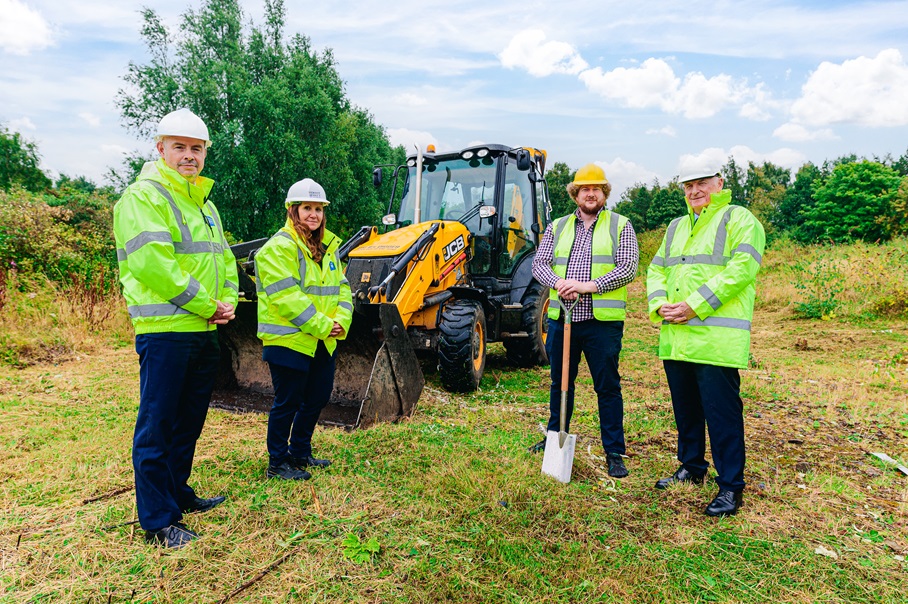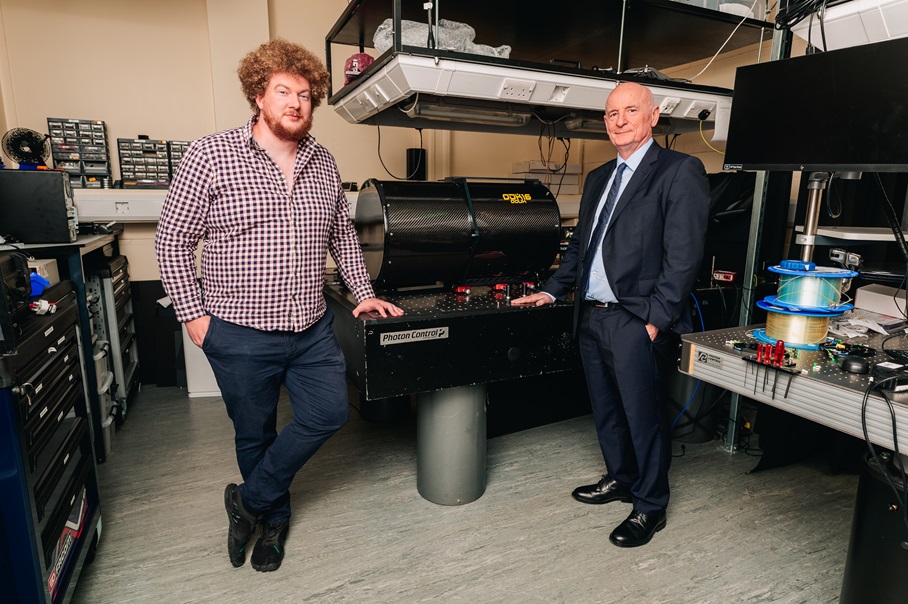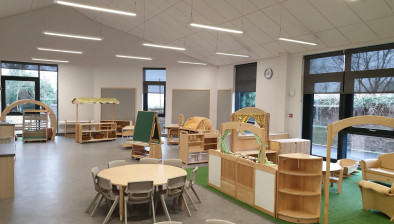Heriot-Watt University breaks ground on new £2.5m optical ground station

(from left) Graham McPhail, Professor Gillian Murray, Dr Ross Donaldson and Professor Gerald Buller
Work has started on a new Quantum Communications Hub Optical Ground Station (HOGS), a state-of-the-art telescope which is being built on Heriot-Watt University’s Research Park.
The new facility will demonstrate and test satellite quantum secure communications, maintaining and growing the UK’s strength in the field of quantum technologies. It is scheduled to be fully operational by late Autumn.
As well as helping to tackle future cyberattacks by researching methods to send secure transmissions via satellites, it will unlock new research on space environmentalism alongside innovative R&D activities for future laser communication networks. These provide high bandwidth communications services like 6G and beyond.
The facility will feature a plethora of cameras, sensors, and other photonic technologies enabling HOGS to expand how it can be used for both UK-based and international researchers and industry contacts. HOGS will also be directly connected to a new University campus optical fibre network, being developed alongside HOGS, allowing innovative teams to demonstrate deployment of optical, quantum, and hybrid communication networks.
The new capabilities will support space environmentalism by finding debris, accurately tracking satellites and developing new techniques to find objects that haven’t been seen before and improving the identification of what the object is. The telescope may also open opportunities for teams to explore new de-orbiting techniques for small space debris using lasers.
The facility is being built as part of the Quantum Communications Hub project, funded through the UK National Quantum Technologies Programme and is part of a collaborative effort which also involves the Universities of Bristol, Strathclyde, and York. Space engineering expertise is provided by the Science and Technology Facilities Council’s RAL Space Facility.
Other UK researchers with relevant interests in experimental satellite quantum communications will be invited to work onsite using the modern telescope to track satellite paths with high precision. Heriot-Watt students, from undergraduate to PhD, will benefit from the new capabilities while local school children will be hosted onsite to build their knowledge and understanding of satellite communications and astronomy.
Dr Ross Donaldson from Heriot-Watt University is leading the project. He said: “We want to show that UK scientists have the capabilities to deliver satellite quantum-based communications and have the expertise to do all the required operations. Creating secure global connectivity is the goal and we look forward to demonstrating our abilities once the Optical Ground Station is up and running.
“This new facility will provide UK and international teams with the opportunity to trial new techniques and technologies for innovative R&D as well as space environmentalism. Our high latitude location offers us the chance to track space junk and debris in polar orbits for long periods of time, which may allow us to identify smaller objects.”

Dr Ross Donaldson and Professor Gerald Buller with equipment that will be used in the new Optical Ground Station
Professor Tim Spiller, director of the Quantum Communications Hub, said: “Satellites will form an essential part of future worldwide quantum communications, and in-orbit demonstrator missions are essential in proving the UK’s capabilities as a leader in secure quantum communications. The ground-based receiver is clearly a key element of any mission, and we look forward to the Hub Optical Ground Station becoming operational at Heriot-Watt University.”
Heriot-Watt University has world-leading expertise in quantum communications and associated technologies behind it. The new HOGS facility represents a major step towards creating a ‘space cluster’ on the institution’s Edinburgh campus.
Professor Gill Murray, deputy principal of business and enterprise at Heriot-Watt University welcomed the work beginning on site. She said: “Heriot-Watt University is at the forefront of creating and supporting new growth sectors through our research, innovation and pipeline of talented students. Our new Optical Ground Station will create a dynamic new environment where innovation is encouraged. We have seen an explosion in growth within the space technology sector and higher education has a key role to play to capitalise on this growth.
“By actively engaging with businesses that operate in the space sector, we can push the boundaries of what is possible. Our researchers and students bring fresh perspectives, diverse skill sets, and a passion for discovery. Through forging partnerships with industry partners, business leaders and government, we can fully maximise resources like the new Optical Ground Station to channel academic energy into practical solutions, driving advancements that benefit both higher education and broader society.”
Graham McPhail, head of property strategy at Heriot-Watt University, added: “Having the Optical Ground Station on the university’s campus further elevates Heriot-Watt’s space and quantum potential beyond those offered by other research parks.
“As the largest and most prominent of Scotland’s science-based parks, with more than 1,000 staff working across 28 organisations, companies occupying Heriot-Watt Research Park can make full use of the amenities available on the campus in a location that offers unrivalled access to Scotland’s capital city and the central belt. Every day the campus is filled with our talented students, researchers and existing industry partners including Celestia UK, renowned for its expertise in antenna systems for satellite tracking.
“We are also supporting the university’s wider sustainability goals, ensuring we use existing campus infrastructure and minimise transport costs wherever possible. Operating from the campus means students that are studying our new Aerospace Engineering degree and aligned qualifications can benefit from access, helping the University to produce workplace-ready graduates who are able to meet the requirements of this emerging sector.”
Last month, Heriot-Watt announced it will lead a groundbreaking new quantum research hub that aims to develop technologies to progress an ultra-secure quantum internet of the future. The Integrated Quantum Networks (IQN) Hub is one of five new quantum technology hubs announced by the UK government as part of a £160 million investment to ensure the UK remains at the forefront of these revolutionary technologies. The IQN Hub will build on the work of the current Quantum Communications Hub, including space, to create new use cases for HOGS in the future.
The build will include the expertise of EC Specialist Contractors, Harley Haddow and ECD Architects.





















